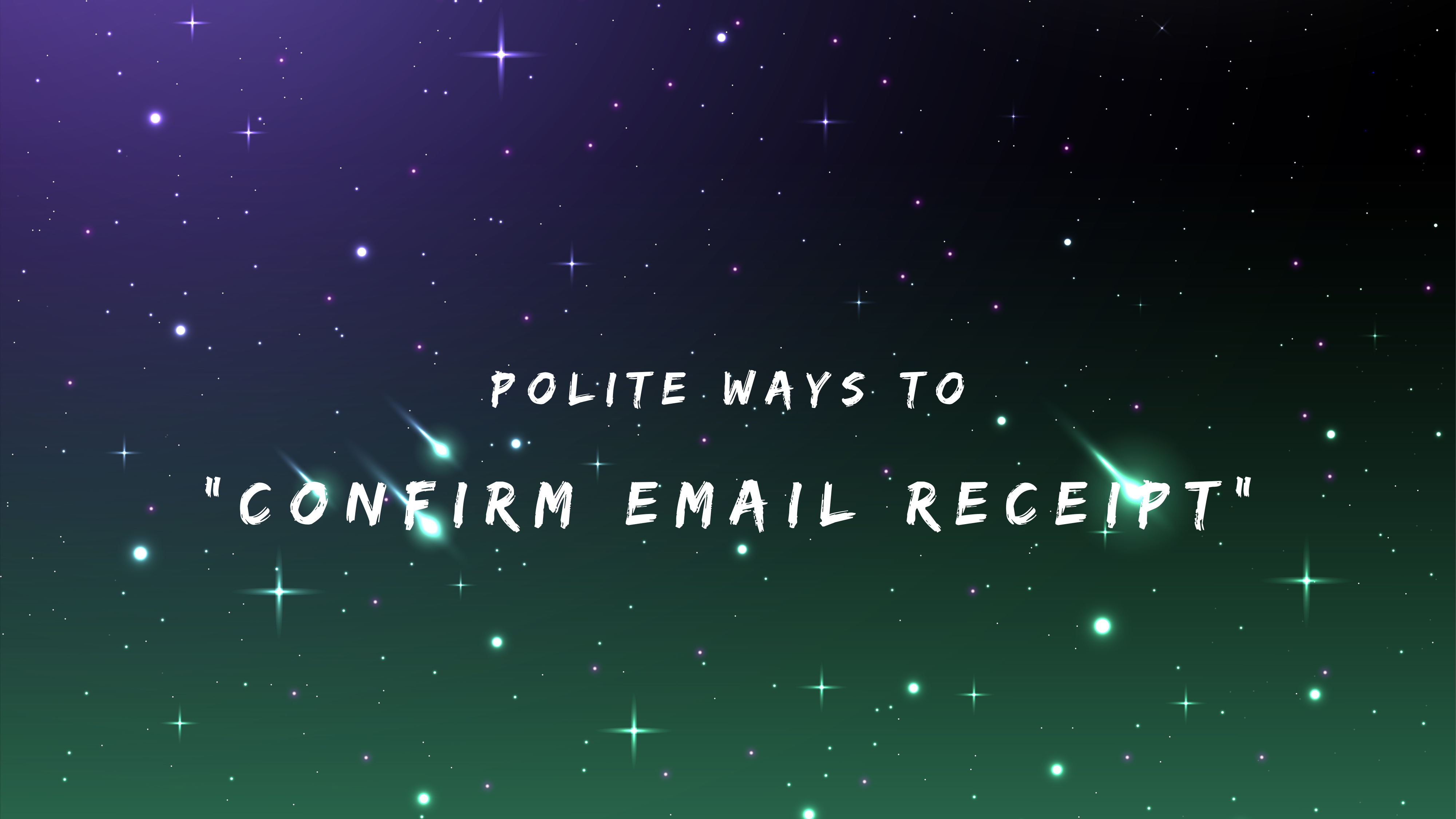In today’s digital world, emails have become a cornerstone of communication. Whether you’re handling business deals, customer service queries, or simply catching up with friends, knowing how to confirm the receipt of an email is essential appropriately. This seemingly small act of acknowledging an email can prevent misunderstandings, ensure clarity, and foster positive relationships. But what exactly does it mean to “Confirm Email Receipt”? Let’s dive into the intricacies of this essential communication practice.
Why It’s Important to Confirm Email Receipt
Confirming email receipt is more than a polite gesture; it’s critical to effective communication. It shows the sender that their message has been received and understood, which is vital in professional and personal settings. But why is it so important?
- Professional Courtesy
In professional environments, acknowledging an email demonstrates respect and attentiveness. It assures the sender that their message has been received and will be addressed promptly. This simple act can enhance your professional reputation and foster trust with colleagues, clients, and partners.
- Avoiding Miscommunication
Miscommunication can lead to confusion, delays, and even conflicts. Confirming email receipt can prevent these issues by ensuring that both parties are on the same page. It also allows for clarifying any points of uncertainty or concern.
- Building Trust and Reliability
Consistently acknowledging emails build a reputation for reliability. It shows you are attentive and responsible and value others’ communication. This trust is crucial in business relationships and can significantly impact your professional image.

150+ Ways to “Confirm Email Receipt”
Formality
- Formal Response: Dear [Name], I confirm receipt of your email and will review it shortly.
- Polite Acknowledgment: Thank you for your email. I have received it and will get back to you soon.
- Professional Confirmation: Your message has been received. I will contact you shortly regarding the next steps.
- Brief Formal Reply: Acknowledged. I will review the contents and respond in due course.
- Detailed Formal Response: Dear [Name], I have received your email. I am currently reviewing the details and will respond with a comprehensive reply shortly.
- Confirm Receipt and Action: Thank you for your email. I have received it and will address your request by [specific date/time].
- Formal Follow-Up: I appreciate your email. I have received it and will follow up with you within the next [time frame].
- Official Acknowledgment: This email confirms that your message has been received and is under review.
- Formal Request for Confirmation: Please confirm that you have received this message as part of our formal acknowledgment process.
- Structured Formal Reply: Dear [Name], I am writing to acknowledge receipt of your email dated [date]. Your message has been received and is currently being processed.
Medium
- Email Reply: Just replying to confirm that I’ve received your email. Thanks for sending it.
- Phone Call: Hi [Name], I received your email. Talk soon.
- Text Message: I received your email, thanks! I’ll get back to you soon.
- In-Person Confirmation: I saw your email and just wanted to confirm that I’ve received it.
- Messaging App: I got your email. I’m letting you know I’ve seen it and will review it.
- Automated Response: Thank you for your email. This is an automatic response to confirm that your message has been received.
- Voicemail: Hi [Name], this is [Your Name]. I received your email and will review it as soon as possible. Thanks!
- Social Media Message: Hey, I got you. This is our email. I’ll be in touch soon.
- Confirmation: This fax confirms that your email has been received. Thank you for sending it.
- Online Form Acknowledgment: Thank you for filling out the form. We have received your submission via email.
Technology
- Read Receipt: You will receive a notification once the recipient has read your email.
- Email Tracking Software: The tool confirms that the recipient opened your email.
- Autoresponder: This automated message confirms that your email has been successfully received.
- Confirmation Link: Please click the link to confirm that you have received this email.
- Delivery Receipt: The delivery receipt indicates that your email has been successfully delivered to the recipient’s inbox.
- CRM System Update: The CRM system shows that the email was received and logged in the recipient’s communication history.
- Custom Acknowledgment Feature: Use the built-in feature in your email client to request an acknowledgment of receipt.
- Email Confirmation API: The API confirms that the recipient’s server has received your email.
- Server logs indicate that the recipient’s email server has received your email.
- Read Notification Settings: You have enabled read notifications for this email to confirm when the recipient opens it.
Context/Occasion
- Business Proposal: Thank you for your business proposal. I have received it and will review it by [date].
- Meeting Request: I’ve received your request for a meeting. I’ll check my schedule and confirm a time with you soon.
- Job Application: Thank you for applying for the [Job Title] position. Your application has been received and is under review.
- Invoice Submission: I confirm receipt of your invoice. I will process it and reply with any questions or payment confirmation.
- Customer Support: We’ve received your support request. Our team will review it and reply within [time frame].
- Event Registration: Thank you for registering for the event. Your registration has been received and confirmed.
- Document Submission: We have received your document. We will review it and provide feedback as soon as possible.
- Feedback Submission: Thank you for your feedback. We’ve received it and will consider it in our ongoing improvements.
- Contract Review: We have received your contract. We will review it and contact you with any comments or questions.
- Partnership Inquiry: We’ve received your inquiry about a potential partnership. We will review the details and get back to you shortly.
Timing
- Immediate Acknowledgment: I received your email and will reply soon.
- Within 24 Hours: I have received your email. I’ll respond with a detailed answer within the next 24 hours.
- End of Business Day: This is just a quick note to confirm that I’ve received your email. I’ll address it by the end of the business day.
- Next Working Day: I confirm receipt of your email. I’ll review it and get back to you by tomorrow.
- As Soon As Possible: Your email has been received. I’ll respond soon, likely within the next few hours.
- During Business Hours: Acknowledged. I’ve received your email and will review it during business hours today.
- Scheduled Response: Thanks for your email. I’ll be able to give you a detailed response by [specific time or date].
- Within 48 Hours, I received your email. Expect a detailed response within the next 48 hours.
- Weekly Update: Your email has been received. I will include it in our weekly review and get back to you then.
- Specific Date/Time: I am just confirming receipt of your email. I will follow up with a detailed response by [specific date/time].
Content-Type
- Simple Acknowledgment: Received your email. Thanks for sending it.
- Content Reference: I’ve received your email and noted the details. I’ll be in touch with comments on the points you raised.
- Action Required: Thank you for your email. I’ve received it and will take the necessary actions as discussed.
- Request for Confirmation: I received your email. Please confirm if the attached document was included correctly.
- Confirmation with Next Steps: Your email has been received. I’ll proceed with [specific next steps] and update you accordingly.
- Detailed Feedback: Thanks for your email. I have received it and will provide feedback on [specific content] soon.
- Information Review: Received your email with the information. I’ll review the details and get back to you shortly.
- Acknowledgment with Clarification: I confirm receipt of your email. Please clarify [specific point] so I can address it properly.
- Action Confirmation: Thank you for your email. I’ve received it and will act on your request by [specific action].
- Follow-Up Confirmation: Your email has been received. In my next message, I’ll follow up with more details on [specific topic].
Response Tone
- Neutral Tone: Thank you for your email. I’ve received it and will review it soon.
- Friendly Tone: I received your email. Thanks for sending it!
- Enthusiastic Tone: I got your email! I’m excited to review it and will get back to you shortly.
- Professional Tone: This is to acknowledge receipt of your email. I will review the content and respond accordingly.
- Reassuring Tone: I’ve received your email, and everything looks good. I’ll be in touch soon with any updates.
- Appreciative Tone: Thanks for your email. I confirm receipt and appreciate you getting in touch.
- Cordial Tone: Your email has been received. I’ll respond to you soon oon. Have a grey!
- Supportive Tone: I’ve received your email and am here to help. I’ll review it and get back to you as soon as possible.
- Casual Tone: I’m just letting you know I got your email. I’ll check it out and reply when I can.
- Polite Tone: Thank you for your email. I confirm receipt and will provide a detailed response shortly.
Recipient’s Role
- Individual Recipient: I’ve received your email. I’ll review it and get back to you directly.
- Team Acknowledgment: The team has received your email. We’ll discuss it and get back to you with a collective response.
- Manager Response: as your manager, I confirm receipt of your email. I’ll review it and provide feedback.
- Support Role: Our support team has received your email and will handle it. Expect a response shortly.
- Departmental Confirmation: This is to confirm that your email has been received by the [Department Name]. We will address it soon.
- Collaborator Response: I’ve received your email. As a collaborator on this project, I’ll review it and get back to you with my input.
- Customer Service Role: Our customer service team has received your email. We’ll contact you to assist you.
- Admin Confirmation: As the administrative assistant, I confirm receipt of your email and will forward it to the appropriate person.
- Project Lead: I’ve received your email. As the project lead, I’ll review it and update the team accordingly.
- Executive Confirmation: This is to acknowledge that I, as the executive, have received your email and will review it in detail.
Confidentiality Level
- Confidential: I confirm receipt of your email. Rest assured, your information will be treated with the utmost confidentiality.
- Sensitive Information: Your email has been received. The contents will be handled with discretion and only shared with relevant parties.
- Private: I’ve received your private email. It will be reviewed carefully and kept confidential.
- Secure Handling: Confirmation received. Your email will be processed securely to ensure confidentiality.
- Protected Information: I acknowledge receipt of your email. The information you provide will be protected and used appropriately.
- Non-Disclosure Assured: Thank you for your email. I assure you that the details will not be disclosed to unauthorized individuals.
- Discreet Handling: We have received your email. We will handle the content discreetly, per our confidentiality protocols.
- Confidential Acknowledgment: I confirm receipt of your confidential email and will ensure that all information remains secure.
- Privileged Information: Received your email containing privileged information. It will be treated with strict confidentiality.
- Secure Acknowledgement: This is to confirm receipt of your email. Your information is safe and will be reviewed confidentially.
Acknowledgment Method
- Direct Response: I received your email and am confirming receipt. I’ll review it and get back to you soon.
- Read Receipt Notification: This automatic notification confirms that your email has been read.
- Acknowledgment Link: Please click this link to confirm that you received my email.
- Manual Reply: I’m just letting you know that I’ve received your email. I’ll follow up with more details shortly.
- Automated Reply: Thank you for your email. This automated response confirms that your message has been received.
- Receipt Confirmation Form: Please complete this form to acknowledge receipt of my email and confirm that you have reviewed the attached document.
- Phone Call Follow-Up: Hi [Name], I received your email and am calling to confirm. We’ll discuss it further in our next meeting.
- Text Message Confirmation: Just confirming receipt of your email. I’ll get back to you with more information soon.
- In-Person Confirmation: I saw your email and wanted to let you know in person that I’ve received it and will review it.
- Email Tracking Tool: Your tool confirms that my message has been received and opened.
Recipient’s Communication Style
- Concise: I got your email. I’ll get back to you shortly.
- Detailed: Thank you for your email. I confirm receipt and will provide a detailed response once I review the contents.
- Formal: I acknowledge receipt of your email and will address it according to our formal communication procedures.
- Casual: Hey, just confirming that I received your email. I’ll check it out and reply soon!
- Friendly: Thanks for your email! I received it and will contact you after I have read it.
- Professional: Your email has been received and is currently under review. I’ll get back to you with a comprehensive response.
- Supportive: I received your email. I’m here to help and will get back to you with the necessary support.
- Efficient: Acknowledged. Your email has been received and will be processed as quickly as possible.
- Engaging: Thanks for reaching out! I received your email and am looking forward to diving into the details. I’ll follow up soon.
- Thorough: I confirm receipt of your email and will take time to review the content thoroughly before responding.
Relationship Status
- New Contact: Thank you for your email. As this is our first communication, I wanted to confirm that I’ve received it.
- Acquaintance: Hi [Name], I received your email. It’s great to hear from you. I’ll review it and get back to you soon.
- Established Relationship: I received your email. As we have been working together for some time, I’ll review it and follow up as usual.
- Client: Thank you for your email. I confirm receipt and will contact you shortly to address your concerns.
- Team Member: Your email has been received. I’ll review it and coordinate with the team as needed.
- Manager: I’ve received your email. As your manager, I’ll review the content and reply with any feedback or next steps.
- Colleague: Thanks for your email. I confirm receipt and will discuss it with our team before getting back to you.
- Vendor: We received your email. I’ll review the details and contact you regarding any further actions required.
- Partner: Your email has been received. As a partner, I’ll review it and follow up to ensure we’re aligned on the next steps.
- Mentor/Mentee: I confirm receipt of your email. Based on our ongoing discussions, I’ll review it and provide feedback or guidance.
Priority Level
- High Priority: Thank you for your urgent email. I confirm receipt and will address it immediately.
- Normal Priority: I’ve received your email. It’s important, and I’ll respond within the usual timeframe.
- Low Priority: Your email has been received. I’ll review it when I can, but please note it may take longer to respond.
- Urgent Acknowledgement: I received your urgent email. I’m prioritizing it and will respond as soon as possible.
- Routine Confirmation: Thanks for your email. It’s been received and will be handled according to our standard procedures.
- Time-Sensitive: I confirm receipt of your time-sensitive email. I’ll make sure to get back to you before the deadline.
- Standard Processing: Your email has been received. It will be processed in the usual order of priority.
- Immediate Action Required: I’ve received your email and will immediately act as requested. I’ll follow up shortly.
- Delayed Response: Your email has been received. Due to current workloads, I may take a bit longer to respond, but I’ll get to it soon.
- Critical Issue: Thank you for your email about the vital issue. I confirm receipt and will address it with the highest priority.
Cultural Considerations
- Formal Greeting: Dear [Name], I acknowledge receipt of your email. Thank you for reaching out.
- Respectful Acknowledgment: Thank you for your email. I confirm receipt and will handle it with the respect and attention it deserves.
- Polite Confirmation: I’ve received your email. I appreciate your patience as I review the details and respond accordingly.
- Warm Acknowledgment: Thank you for your email. I confirm receipt and look forward to discussing this further with you.
- Culturally Specific Greeting: Konnichiwa [Name], I have received your email. I will review it and respond to our cultural norms.
- Gratitude Emphasis: I received your email. Thank you for your detailed message; I will ensure it gets the attention it deserves.
- Localized Formality: Greetings [Name], I confirm receipt of your email. Thank you for contacting me. I’ll review it and respond in due course.
- Respectful Acknowledgment: I appreciate your email. I confirm receipt and will handle the matter with the utmost respect and care.
- Polite Assurance: Thank you for your message. I’ve received it and will address it while honoring our cultural expectations.
- Acknowledgment with Context: I received your email and confirm receipt. Given our cultural context, I will ensure a thorough review and timely response.
Language and Localization
- English Confirmation: I received your email. I’ll review it and get back to you soon.
- Spanish Confirmation: He recibido tu correo electrónico. Lo revisaré y te responderé pronto.
- French Confirmation: J’ai bien reçu votre email. Je vais le lire et je vous répondrai sous peu.
- German Confirmation: Ich habe Ihre E-Mail erhalten. Ich werde sie überprüfen und Ihnen bald antworten.
- Chinese Confirmation: 我已经收到您的电子邮件。我会尽快查看并回复您。
- Localized Greeting: Hello [Name], I’ve received your email. I will respond soon. Thank you for being so patient.
- Multilingual Acknowledgment: Thank you for your email. I confirm receipt and will reply in the language of your preference if needed.
- Localized Formality: Dear [Name], I confirm receipt of your email. I will review it and respond according to our local practices.
- Bilingual Confirmation: Thank you for your email. I’ve received it. Merci pour votre message. Je reviendrai vers vous bientôt.
- Regional Style: I’ve received your email and will reply soon. Thank you for reaching out from [Region].
When to Confirm Email Receipt
Knowing when to confirm an email receipt is as important as knowing how to do it. While not every email requires a confirmation, there are specific situations where it’s particularly crucial.
- Business Communications
In business, timely email acknowledgment can differentiate between sealing a deal and losing an opportunity. Confirming receipt of contracts, proposals, or important updates is essential to maintaining a smooth workflow and ensuring all parties are aligned.
- Customer Service Interactions
For customer service teams, confirming email receipt reassures the customer that their inquiry or complaint is being handled. It sets expectations and shows that their concern is being taken seriously, which can enhance customer satisfaction and loyalty.
- Personal and Informal Situations
Confirming email receipt can be courteous, even in personal or informal settings. It might only sometimes be necessary, but it can show appreciation and respect, especially when coordinating plans or important events.
How to Confirm Email Receipt Politely
The tone and content of your email confirmation can vary depending on the context. Here’s how to do it gracefully:
Basic Acknowledgment
Sometimes, a simple acknowledgment is all that’s needed. This can be a brief message letting the sender know you’ve received their email.
- Simple Confirmation
Example: “Received your email, thanks!” - Expressing Gratitude
Example: “Thank you for sending over the documents.”
Detailed Acknowledgment
A more detailed acknowledgment may be appropriate in other situations, especially in professional settings. This involves summarizing the main points and outlining any next steps.
- Reiterating Key Points
Example: “Thank you for your email regarding the project timeline. We have noted the proposed dates and will review them with our team.” - Clarifying Next Steps
Example: “I’ve received your request for a meeting. I’ll check my availability and get back to you with a suitable time.”
Best Practices for Confirming Email Receipt
To ensure your email acknowledgment is effective, keep these best practices in mind:
- Timeliness
Responding promptly is key. A quick acknowledgment shows you’re attentive and responsible even if you can’t respond immediately. It’s also helpful to set expectations for when a more detailed response will follow.
- Professional Tone
Always consider the tone of the original email and match it accordingly. If the sender used a formal tone, it’s best to respond in kind. However, even in informal exchanges, maintaining professionalism is crucial.
Email Templates for Confirming Receipt
Having a few go-to templates can save time and ensure consistency. Here are some examples:
Formal Template
“Dear [Name],
I have received your email dated [Date]. Thank you for the information. I will review it and get back to you by [Date].
Best regards,
[Your Name]”
Informal Template
“Hey [Name],
I just got your email. Thanks for sending it over! I’ll take a look and let you know my thoughts.
Cheers,
[Your Name]”
Customer Service Template
“Hello [Customer Name],
Thank you for contacting [Company]. We have received your inquiry and will respond within [Time Frame].
Best,
[Your Name/Customer Service Team]”
Common Mistakes to Avoid When Confirming Email Receipt
While confirming email receipt is straightforward, there are pitfalls to avoid:
- Being Too Casual in Professional Settings
Even if you’re comfortable with the sender, always maintain a professional tone in work-related emails. Overly casual responses can come off as unprofessional and may be misinterpreted.
- Delaying the Acknowledgment
Prompt responses are crucial. Delaying acknowledgment can cause unnecessary anxiety for the sender and might lead to misunderstandings.
- Overcomplicating the Response
Keep your acknowledgment clear and concise. Overloading your message with unnecessary details can confuse the recipient and obscure the main point.
Tools and Technologies for Managing Email Receipts
In the age of digital communication, various tools can help streamline the process of confirming email receipts:
- Email Management Software
Tools like Microsoft Outlook, Gmail and specialized software like Mailbird or Spark offer features that help manage and track email acknowledgments. They can automate responses, set reminders, and organize correspondence.
- Automated Responses
Automation tools can send immediate acknowledgments, ensuring the sender knows their email has been received. This is particularly useful in customer service settings where quick response times are essential.
The Role of Cultural Differences in Email Acknowledgment
Different cultures have unique communication styles, and understanding these nuances can enhance your email interactions.
- Understanding Cross-Cultural Communication
Some cultures prioritize formality and detailed responses, while others value brevity and informality. Being aware of these differences can help you tailor your email acknowledgments appropriately.
- Adapting Your Approach
For example, formal acknowledgments and expressions of gratitude are essential in Japanese business culture. In contrast, Scandinavian cultures might appreciate straightforward and concise communication.
Real-Life Scenarios: When Confirming Email Receipt Made a Difference
Let’s look at some real-life examples where confirming email receipt played a crucial role:
- Successful Business Transactions
In one instance, a quick acknowledgment of a client’s email prevented a major misunderstanding. The client had sent over crucial changes to a contract, and the prompt acknowledgment allowed for immediate discussion and adjustments.
- Effective Customer Service
A customer sent an email regarding a malfunctioning product. The company’s quick acknowledgment reassured the customer that their issue was being addressed, leading to a swift resolution and positive feedback.
The Future of Confirming Email Receipts
As technology evolves, so does the way we communicate. What’s next for email acknowledgments?
- Trends in Digital Communication
The rise of instant messaging and collaboration tools like Slack and Microsoft Teams may reduce the frequency of email confirmations. However, emails remain a formal communication method in many industries, keeping acknowledgments relevant.
- The Impact of AI and Automation
AI-driven email tools can analyze the tone and content of incoming emails, generating appropriate responses. This technology can streamline communication and ensure that acknowledgments are timely and accurate.
Conclusion
In conclusion, mastering the art of politely confirming email receipt is a valuable skill to enhance professional communication. With over 150 options, you can find the perfect response for any situation, whether it’s a formal business setting or a casual exchange. Remember, a well-crafted acknowledgment shows respect and attentiveness and helps maintain clear and organized communication. For more tips on how to navigate tricky conversations and respond thoughtfully,
check out our guide on:
Top 150+ Answers to Common “Are You Sure?” Questions.
FAQs
Q. What should I do if I accidentally delete an email I must confirm?
If you accidentally delete an important email, check your trash or spam folders immediately. If it’s not recoverable, contact the sender and politely ask them to resend it.
Q. Is it always necessary to confirm email receipt?
It only happens sometimes but is a good practice, especially in professional settings. It ensures that the sender knows their message was received and appreciated.
Q. How can I confirm email receipt in a language I’m not fluent in?
Use translation tools like Google Translate to craft a simple acknowledgment. Be clear and concise to avoid misunderstandings.
Q. What are the best tools for managing email confirmations?
Email management tools like Microsoft Outlook and Gmail and specialized software like Mailbird and Spark offer features to streamline the process.
Q. Can confirming email receipt make a difference in personal relationships?
Absolutely! It shows attentiveness and respect, which can strengthen personal connections and prevent misunderstandings.











Simply desire to say your article is as surprising The clearness in your post is simply excellent and i could assume you are an expert on this subject Fine with your permission let me to grab your feed to keep up to date with forthcoming post Thanks a million and please carry on the gratifying work